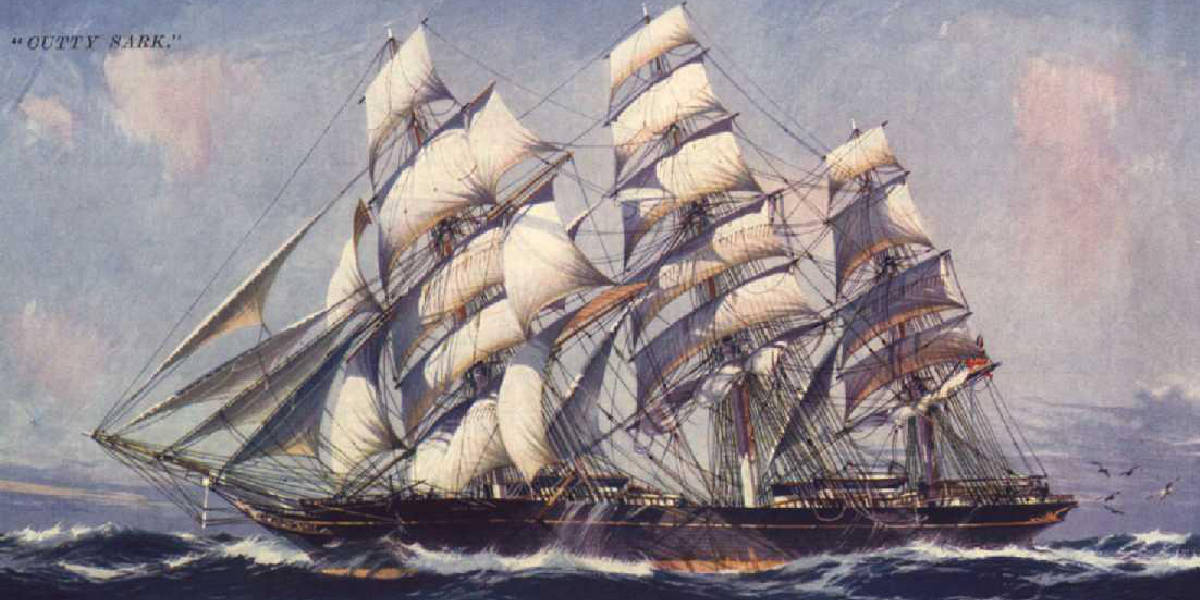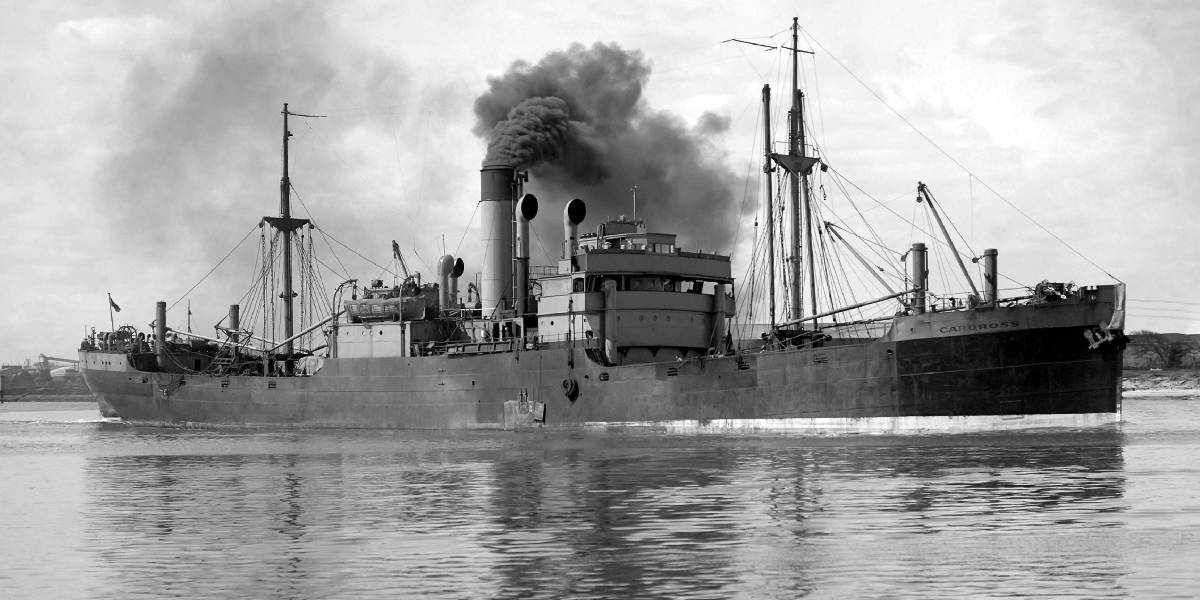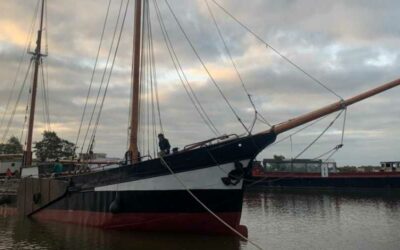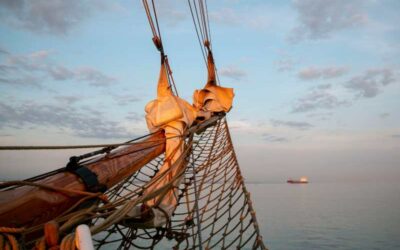By Capt. Jorne Langelaan
A Short story about the transition of shipping.
When steam was introduced, sailors regarded a shipmate who would leave the sailing ships and move over to work on a steamship, as somebody who left the sea.
For the real seaman, sailing was all about working with the natural elements like: weather, climate, tides and current. The sailor of the true wind ship would know about the sea life surrounding him: dolphins, whales, albatrosses, bonitoes and flying fish. Merchant sailing ship captains of those days, would often have a great interest in the wonders of the deep. They would examine and classify the specimens of the sea, like nowadays scientists are doing in their laboratories.
As the great historian Basil Lubbock wrote:
“In fact they knew the sea; and there are not many men who earn their living on the great waters who can say the same today.”
That was 1922, when steam had taken over all major shipping trades. I wonder how much knowledge of the weather, and the sea, and what lives below her surface, is left with the merchant seamen of 2023…
Learning from the past
Yet, to really respect our natural world, one needs to know about it. And not only know about it but experience its unbelievable complexity and beauty. Apart from emission free shipping, a renewed connection with nature, is what a return to sail has to offer.
Personally, I have had the luxury and privilege to have served in sail for many years. Learning under the few experienced sailing ship masters, who still knew and know their trade. Men like: Capt. Jan Duinmeijer who introduced me to sailing, Capt. Paul Wahlen of the “last” trading schooner Avontuur, Capt. Harry Muter with his beautiful brigs Jantje and Morgenster, Capt. Klaas Gaastra explorer of the seas with Europa, and Capt. Daniel Moreland commanding Picton Castle in numerous circumnavigations, all of them with great interest in the natural world. Later on, when I took command myself, on sailing ships without mechanical propulsion, this attachment to nature grew even more, it became the main principle of importance in my worldview.
All of the above is just to explain the title, and the deeper why, of our company EcoClipper, or in a broader perspective, our new industry of emission free shipping by sailing vessel.
The true subject of this post is how we can learn from the transition from sail to steam. Learn from it, so we will be able to move more smoothly in the other direction: from motor to sail.

* Steamship Savannah
Fire and Smoke
Although a steamboat was already described and patented by the English physician John Allen in 1739, and some first prototypes were tested by other engineers in France, it took until 1803 before the first working model was successfully underway, before it sunk. This was the boat of the American engineer Robert Fulton. Then in 1807, Fulton launched the first commercial steamboat to be operated on the Hudson river. In Europe things developed slightly later with the first commercial steamboat, the Comet, to start operating in 1812, on a passenger line on the river Clyde in Scotland.
At sea, due to the conservative nature of the industry and inefficiency of the innovation, things developed much slower. In 1819, the first ship with steam power crossed the Atlantic, this was the Savannah, still with a sailing rig for safety and most of the time for propulsion. This additional sailing rig, continued to be the norm for many years to come. Almost ten years later the first objections about steam ships, of some sailing ship owners were heard in British parliament.
However, in those days, sail was still ruling in all trades, because it took until the second half of the 19th century that steamships started with running reliable long-distance cargo, passenger and mainly, highly subsidized state mail services. And even then, shippers and passengers were valuing sailing ships for their cool holds and fresh air.
Long distance voyages were hard to be made, by a steamship, because she would need frequent stops for bunkering coal. The coal in these bunker stations was brought from all over the world by, yes, you read it well: sailing ships. With their comparatively lower investments, less costly crew and free wind, the sailing vessel was still more economical than steam. And for bulk cargoes like coal, sail remained for a long time, the propulsion mode of choice.
Innovations in sail and steam
The shipping world, because of her comparatively dangerous environment and secluded nature, has always been conservative and slow to change. Yet, in thousands of years of development, ship designs have come a very long way, starting from a raft with a sail of branches, to the complicated full rigged ship of the early 19th century.
Right at the time steam propulsion was invented the overall design of ships also changed rapidly, with many innovations being introduced. In the first half of the 19th century the hull shape of ships changed. The once bluff bowed heavy designs of the “East India men”, were being abandoned under influence of the search for speed, in favour of finer and narrower designs. In the next half of this century, composite building (steel frames and wood planking) was introduced, followed swiftly by the production of iron and later steel ships. This made the possibility to scale up in size, virtually unlimited. Of course, these were innovations were both sail and steam were taking advantage off.
But if we look at the innovations in sailing ship rigs, we can also see a fast succession of developments, mainly geared at scaling up the size of ships, while reducing the number of crew needed to operate them. The first innovation, in this period, was the splitting up, of the full topsail, in two smaller sails. Reducing the efficiency only very slightly, while making an enormous step in bringing down the manpower needed to handle these sails. With the continuous growth of size of ships, iron and steel came in handy as materials for wire rigging and spars. New systems of clewing up (taking in) sails were developed, at the same time that entire new rigs (four masters and five masters) appeared. Probably the greatest inventor to make work on sailing ships easier, was the Scottish Capt. J.C.B. Jarvis. He designed a winch, to minimize the effort tremendously, for setting the sails of square-rigged masts in the right direction to the wind.
In the beginning steam engines were very large and inefficient in fuel use for the amount of power they produced. Throughout the entire 19th century they were further developed from first a single expansion to finally a quadruple expansion engine. Also, whereas in the beginning, the transfer of the power to the water was mainly made with paddles fitted to sidewheels, later on, and especially at sea, the propeller proved more effective. Finally, inventions in building boilers with higher and higher pressure, made, if not fatal, the steam engine a working alternative.
For a very long-time shipowners did not agree on which propulsion type was more viable. Before 1900 it was not uncommon that a steamship or auxiliary steamship was refitted to become a true sailing ship again. Meaning the engine would be taken out, while a sailing rig would be added, because her (new) owners deemed this an easier way of making a profit. For example, this happened with the fast sailing clipper ship Tweed, the ship which became later the inspiration for the world famous, and still preserved clipper ship Cutty Sark.

The ditches that ended sail..
In 1869, the same year that the earlier mentioned clipper Cutty Sark was launched, the Suez Canal opened. Although her builders did not have any intentions to help steam or end sail, it did proof to be a major advantage for steamships trading between Europe and East Asia. Whereas in the past all trade would have gone around the Cape of Good hope, South Africa, this new canal shortened the voyage by many thousands of miles. That is to say, for the steamship, since the route to and from this canal, through the Mediterranean and Red sea, could, due to calms and adverse winds, not be easily navigated by sailing vessels.
On the other side of the world, in Panama, another canal opened in 1914, which could have been a major influence for sailing ship trade. However, in those years the traditional trade in between the West and East coasts of America, around Cape Horn, the most Southern tip of South America, was already in great decline, because of the railways crossing the entire continent of
North America.
Nowadays, due to climate chaos and the melting of the North Pole, we might be encountering another route, the North East passage through the Arctic above Russia, which can benefit vessels propelled by mechanical means. Since this route is less feasible for ships relying purely on the natural power of the wind. For this reason, we may hope, but can barely expect, that this route will be closed by international mandate to preserve, what has been left of the Arctic…
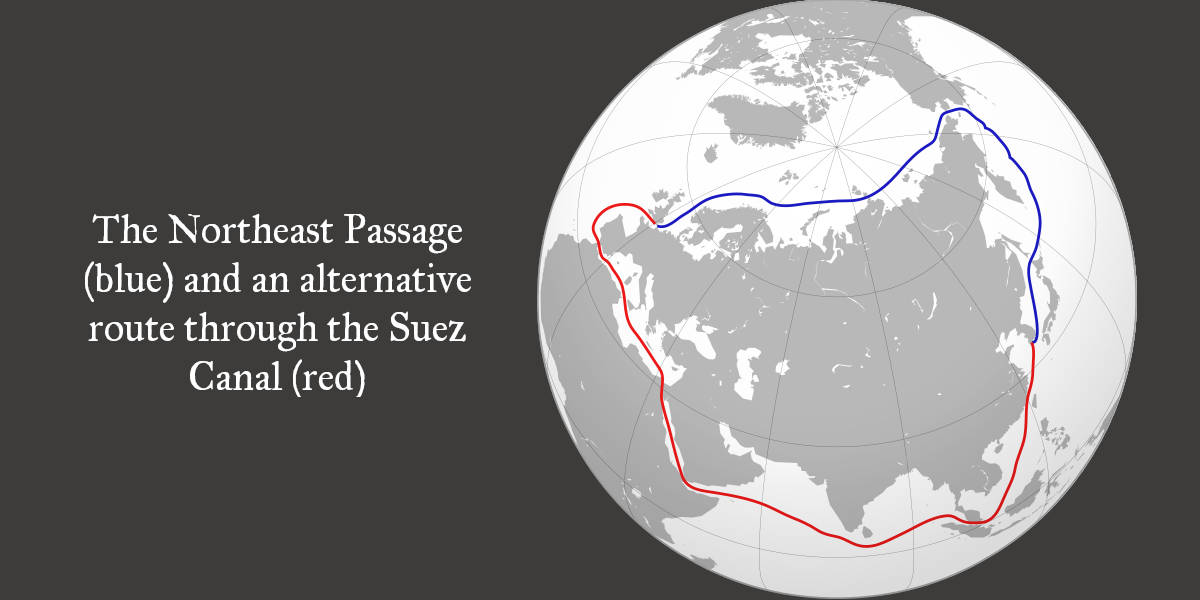
A very long transition
Although in 1860 the tonnage of registered sailing ships was still 10 times that of the steamers, this started to change rapidly, and just before the year 1900 the steamship became more economic, in all but a few trades. Until the 1920s, German shipowners ordered large new built cargo carrying sailing vessels to carry nitrate from the South American West coast, around Cape Horn to Europe. And it was until the 1940’s, almost 150 years after the commercial introduction of steam power at sea, that one man, Capt. Gustaf Erikson kept a fleet of sailing ships trading around the world. This were large three and four-mast barques occupied in the grain trade from Australia to Europe.
Even now, some of the traditional sailing ship trades, although very small scale, have not totally disappeared. There are still the wooden ships, of the Portuguese tradition, in Bahia the Salvador, Brazil, supplying the local markets under sail. The schooners, who even after motorization of the Dhows, prevail in Madagascar. And, the Caribbean sloops, mainly as a tradition without trade, but some still carrying firewood and fruit.

Gustaf, last man standing..
At this place we still have to talk a bit about the remarkable case of Capt. Gustaf Erikson. A man who followed an extraordinary career at sea and became the last of the large sailing ship owners. He started as a ships boy at age 9 and climbed the ranks throughout his teenage years, to become master of a sailing cargo ship in the North Sea trading area, before the age of 20. After this he commanded several large square riggers, before becoming a shipowner in the first world war.
He had a simple yet very effective business strategy. He bought sailing ships, wherever he could find them and whenever they were still seaworthy, for scrap prices because their former owners were changing to steam. Then he operated them under Finish flag, uninsured and with small crews. These crews, mainly consisting of young country boys, who, with the Finish economic circumstances, would have a hard time finding a job anywhere else. He would make some extra revenue by taking on passengers and travellers for a fee. And put these ships to use, hauling one cargo a year: grain from Australia. For the shippers he was not only acting to transport their grain, but in the meantime acting to provide his ships as a cheap warehouse, until the first load, brought by steamship, would be sold.
His first ship was the composite barque Tjerimaj, built in 1883 in Amsterdam. He must have made good profits with this vessel in the shipping boom of the war, because his fleet was growing fast after her purchase. From 1913 to 1947 when he passed away, he bought, owned and operated a large fleet of sailing ships.
Against all advise of economists and other business men, he was famous for keeping the flame of sail burning. He said on one occasion
“I like these sailing ships. If I go, they go. But if I stay, they stay”
He was right because when he passed away, and his son took over, also his sailing ships ceased operating and were sold or replaced by steam and motor vessels.
He left the engines and went back to sea
If our forefathers could have looked into the future and realized about climate chaos, and would have had the guts and common sense to act upon it, sail would never have been abandoned in favour of steam. Fortunately, the transition from sail to steam is well documented by very gifted authors like: Joseph Conrad, Basil Lubbock, Alan Villiers and many more. They thought they were ending a chapter in human development, what they really did, they conserved a global logistic system what worked sustainably without putting an irresponsible burden on the generations to come.
For us, we can now look at the era of steam as a short dead-end intermezzo of wasteful industry. Because of looking back we can plan a new transition in the other direction. We are now finding out, how these emission-free sailing economies, sea going cultures, routeing systems and rigging techniques worked. And we are able to build and innovate further on an evolution of thousands of years of sailing ship culture.
Lessons to be learned
FIRST
in the beginning of a large transition, only the fringes and niches of an industry might be affected, later on, it spreads over the entire league. With the invention of steam, it was first used on short inland voyages, eventually moving to liner and mail services, and finally absorbing the entire shipping industry. Right now, we might be experiencing the same with the new sailing ship companies. It started with supplying, far away island states and archipelagos (Avontuur during the days of Capt. Paul Wahlen, Kwai). Now the trade with luxury and speciality goods (Fairtransport, Towt, New Dawn Traders, Timbercoast) is in full swing. The next step of sail, might as well be offering a real alternative for global shipping and long-distance travel (Ceiba,EcoClipper).
SECOND
As soon as a major driver in culture is added, the economy and underlying economic systems are bound to change, nothing can stop it. When speed and reliance became important in the 19th century, there was no way the sailing vessel could survive under these circumstances. Now we also see a new driver introduced: climate change and sustainability, deeming the development of any propulsion burning fossil fuels obsolete in the long run, and making the emission-free ship the only possible winner.
THIRD
A large transition like an entire industry changing its energy source, does not happen overnight. We might be in for a period of change of many years, although with current faster rates of developments, maybe not so long as the change from sail to steam, but possibly still a century.
Now it is up to us, the new pioneers of sail, you and me, to plot a course in the right direction.
That is to say, bound for a future with emission free shipping, and a real connection to our last vast wilderness: the world’s oceans. So, let us leave behind those smoke emitting contraptions of so-called 20th century progress, and let us return and move on with the only fair way of shipping cargo and traveling long distances. And the return of sail will bring us back the sea.

Thanks for signing on,
Following seas and royals all the way!
Captain Jorne Langelaan
Interested to stay updated with in depth information about the sailing cargo industry?
Join our newsletter (below) , for questions or partnerships contact us now.
